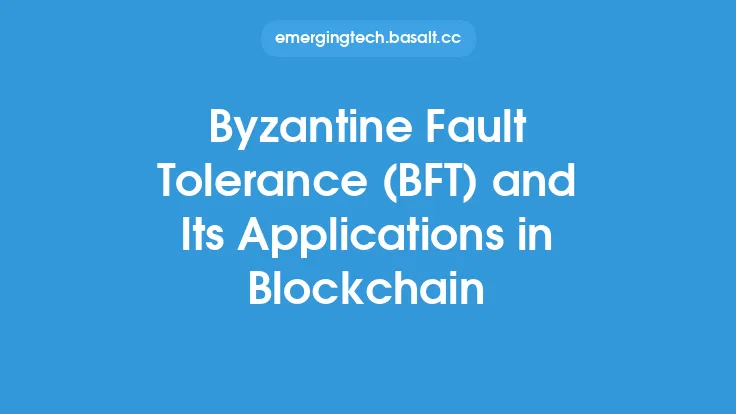The world of blockchain is built on the foundation of consensus mechanisms, which enable decentralized networks to agree on the state of the blockchain. These mechanisms are crucial for ensuring the integrity and security of the network, and they come in various forms, each with its strengths and weaknesses. In this article, we will delve into a comparison of four prominent consensus mechanisms: Proof of Work (PoW), Proof of Stake (PoS), Delegated Proof of Stake (DPoS), and Byzantine Fault Tolerance (BFT).
Introduction to Consensus Mechanisms
Consensus mechanisms are algorithms that allow nodes on a blockchain network to reach a consensus on the state of the blockchain. This is achieved by having nodes verify and validate transactions, and then agree on the order in which they should be added to the blockchain. The choice of consensus mechanism can have a significant impact on the performance, security, and scalability of a blockchain network.
Proof of Work (PoW)
Proof of Work is one of the most well-known consensus mechanisms, used by cryptocurrencies such as Bitcoin and Ethereum. In PoW, nodes on the network compete to solve a complex mathematical puzzle, which requires significant computational power. The first node to solve the puzzle gets to add a new block of transactions to the blockchain and is rewarded with a certain amount of cryptocurrency. PoW is a secure and reliable consensus mechanism, but it has some limitations, such as high energy consumption and slow transaction processing times.
Proof of Stake (PoS)
Proof of Stake is a consensus mechanism that was designed to be more energy-efficient than PoW. In PoS, nodes on the network are selected to add new blocks to the blockchain based on the amount of cryptocurrency they hold, or "stake." The node with the largest stake has the highest chance of being selected to add a new block. PoS is a more energy-efficient consensus mechanism than PoW, but it can be vulnerable to centralization and 51% attacks.
Delegated Proof of Stake (DPoS)
Delegated Proof of Stake is a consensus mechanism that was designed to be faster and more scalable than PoW and PoS. In DPoS, users on the network vote for validators, who are responsible for adding new blocks to the blockchain. The validators with the most votes get to add new blocks and are rewarded with a certain amount of cryptocurrency. DPoS is a fast and scalable consensus mechanism, but it can be vulnerable to centralization and voting manipulation.
Byzantine Fault Tolerance (BFT)
Byzantine Fault Tolerance is a consensus mechanism that was designed to be highly secure and reliable. In BFT, nodes on the network communicate with each other to reach a consensus on the state of the blockchain. BFT is a leader-based consensus mechanism, where a leader node is selected to propose new blocks to the network. The other nodes on the network then verify and validate the proposed blocks, and if a majority of nodes agree, the block is added to the blockchain. BFT is a highly secure and reliable consensus mechanism, but it can be slow and vulnerable to leader manipulation.
Comparison of Consensus Mechanisms
When comparing the four consensus mechanisms, it becomes clear that each has its strengths and weaknesses. PoW is a secure and reliable consensus mechanism, but it is slow and energy-intensive. PoS is more energy-efficient than PoW, but it can be vulnerable to centralization and 51% attacks. DPoS is fast and scalable, but it can be vulnerable to centralization and voting manipulation. BFT is highly secure and reliable, but it can be slow and vulnerable to leader manipulation.
Security Comparison
In terms of security, PoW and BFT are generally considered to be the most secure consensus mechanisms. PoW is secure because it requires significant computational power to launch a 51% attack, while BFT is secure because it requires a majority of nodes to agree on the state of the blockchain. PoS and DPoS are less secure than PoW and BFT, because they can be vulnerable to centralization and 51% attacks.
Scalability Comparison
In terms of scalability, DPoS is generally considered to be the most scalable consensus mechanism. DPoS can process thousands of transactions per second, making it a highly scalable consensus mechanism. PoW and PoS are less scalable than DPoS, because they can only process a limited number of transactions per second. BFT is also less scalable than DPoS, because it requires a majority of nodes to agree on the state of the blockchain, which can be slow.
Energy Efficiency Comparison
In terms of energy efficiency, PoS and DPoS are generally considered to be the most energy-efficient consensus mechanisms. PoS and DPoS do not require significant computational power to secure the network, making them more energy-efficient than PoW. BFT is also more energy-efficient than PoW, because it does not require significant computational power to secure the network. PoW is the least energy-efficient consensus mechanism, because it requires significant computational power to secure the network.
Conclusion
In conclusion, the choice of consensus mechanism depends on the specific needs and goals of a blockchain network. PoW is a secure and reliable consensus mechanism, but it is slow and energy-intensive. PoS is more energy-efficient than PoW, but it can be vulnerable to centralization and 51% attacks. DPoS is fast and scalable, but it can be vulnerable to centralization and voting manipulation. BFT is highly secure and reliable, but it can be slow and vulnerable to leader manipulation. By understanding the strengths and weaknesses of each consensus mechanism, developers and users can make informed decisions about which consensus mechanism to use for their blockchain network.





